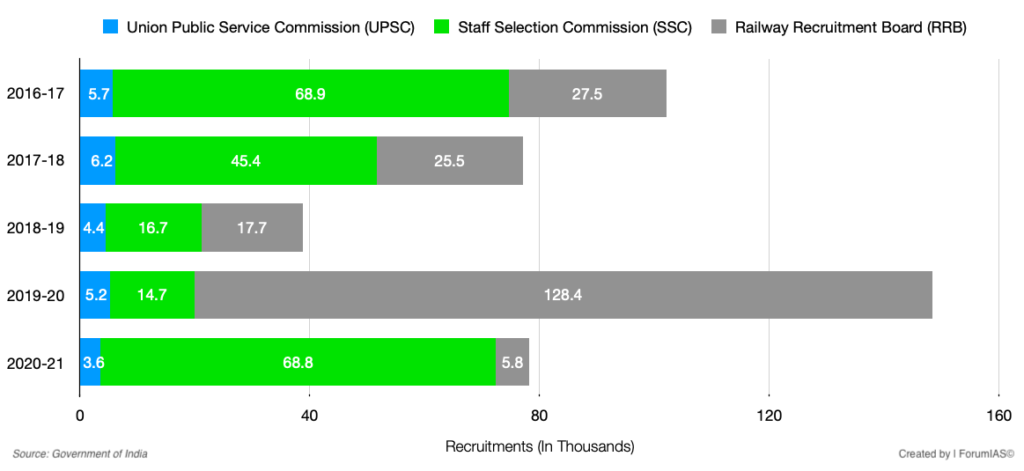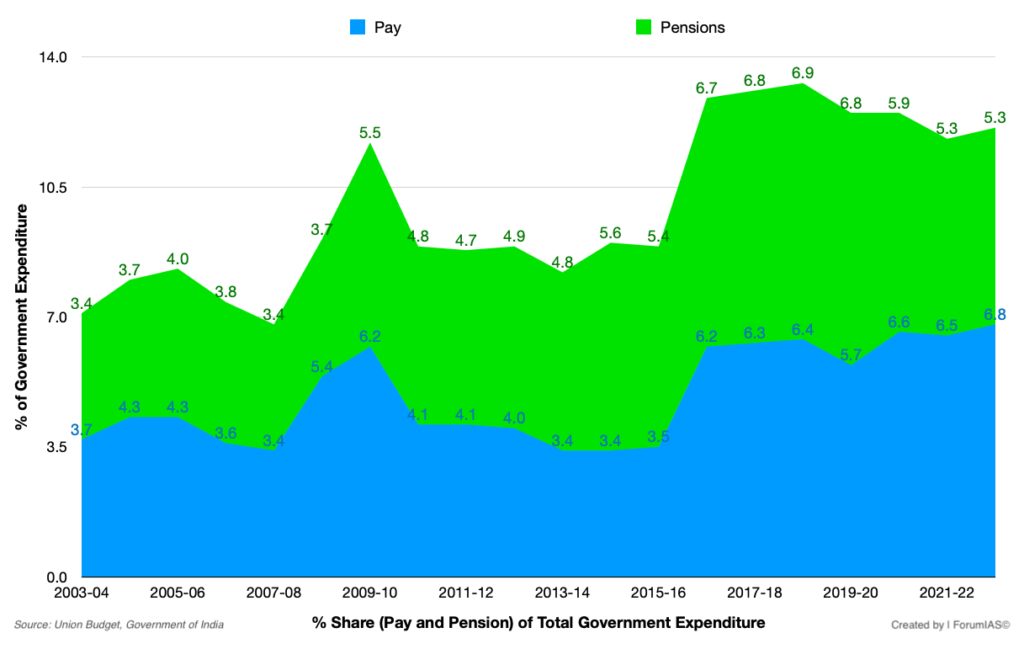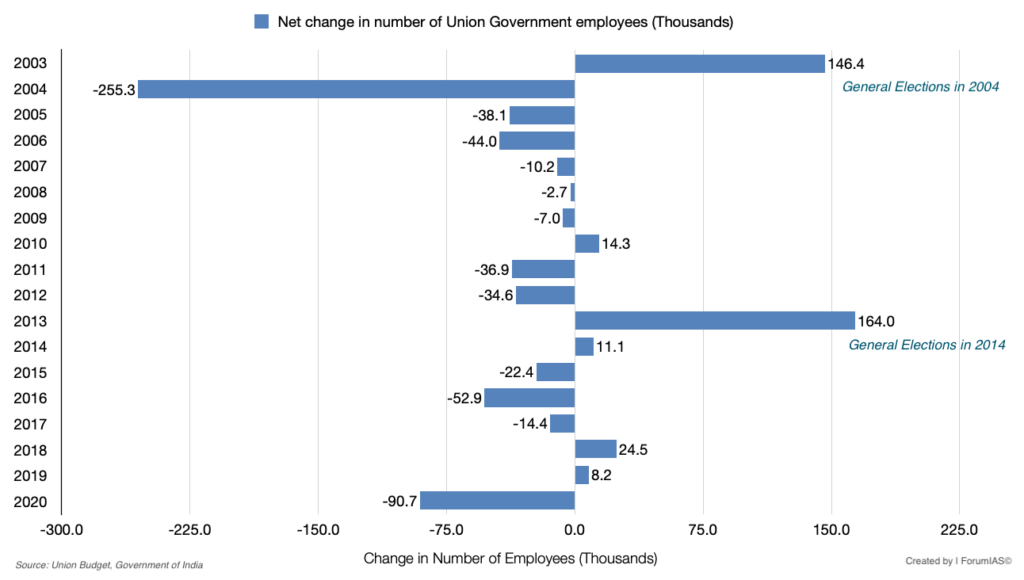ForumIAS announcing GS Foundation Program for UPSC CSE 2025-26 from 19 April. Click Here for more information.
Contents
- 1 Introduction
- 2 What is the current situation of unemployment in India?
- 3 What is the current status of recruitment by the Union Government?
- 4 What is the rationale behind providing 1 million jobs?
- 5 What are the challenges associated with the 1 million jobs proposal?
- 6 What should be the approach going forward?
- 7 Conclusion
| For 7PM Editorial Archives click HERE → |
Introduction
India has been witnessing rising levels of inflation and unemployment since the onset of COVID-19 pandemic. The situation has been worsened by the ongoing Russia-Ukraine conflict. Many economists are saying that poor Indians are facing economic distress due combined impact of unemployment and inflation. To ease the situation, the Union Government has recently announced a plan to recruit 1 million (10 lakh) people in various Government Ministries and Departments over the next 1.5 years. While the decision to create 1 million jobs by the Government is being welcomed, the move has raised several concerns. There has been criticism of Government taking up the role as principal employer in the economy, instead of undertaking economic reforms to create more jobs in the economy.
What is the current situation of unemployment in India?
The leaked Periodic Labour Force Survey (PLFS) in 2018 revealed that India’s unemployment rate was the highest (6.07%) in four decades.
The latest PLFS suggests that the numbers now are not so drastic, with the overall unemployment rate at 4.2% in 2020-21 compared to 4.8% in 2019-20.
In terms of the more widely used statistic internationally, the current weekly status of unemployment, the figure of 7.5% for all persons in 2020-21 is still worrying.
What is the current status of recruitment by the Union Government?
According to the report of the 7th Pay Commission, the total sanctioned strength of the Union Government fell from 41.76 lakh in 1994 to 38.9 lakh in 2014.
In 2021, the strength of the Union Government stood at 34.5 lakh as per the Union budget. Moreover, between 2006 and 2014, the average recruitment in the Union Government was a little over one lakh each year.
Between 2017-18 and 2021-22, the Staff Selection Commission (SSC) and the Union Public Service Commission (UPSC) recruited only 1.74 lakh and 24,836 candidates.
What is the rationale behind providing 1 million jobs?
Changing Structure of Indian Economy: The services sector has rapidly expanded. However, the sector tends to be less employment intensive. Moreover, most of the jobs require skilled workforce. The gig economy does employ the unskilled but fails to create enough jobs for the millions entering the labour force each year. In a similar way, India has not been able to create a robust labour intensive manufacturing sector that is able to absorb the low and semi-skilled sections of the labour force.
Accumulation of Vacancies: A significant number of posts in the government sector are already lying vacant which is impairing governance. The latest data showed that there were 8.86 lakh vacant jobs among all Union government civilian posts as of March 2020.
Demographic Dividend: India has the largest working force in the world. The demographic dividend window will last till 2040s. Finding productive employment for its youth is an imperative for India, else this dividend can easily be turned into a demographic disaster.
Mitigating the Impact of Pandemic: The pandemic led to large loss of livelihoods. Further, it led to a shift of employment into lower productive and unpaid jobs away from salaried employment. Wage rates have continued to remain lower for those employed in either salaried jobs or self-employed compared to the pre-pandemic period. Thus creation of jobs by the government will help in providing some relief.
Global Uncertainties: The ongoing Russia-Ukraine conflict and a looming threat of global recession would reduce consumer demand and consequently poor economic activity. Unemployment is expected to get worse. In this scenario, the creation of 1 million jobs by the government would be beneficial in mitigating the impact.
What are the challenges associated with the 1 million jobs proposal?
Lack of Absorptive Capacity of Government: The recent recruitment data shows that government employment actually forms a small proportion of the formal labour force, and an even smaller part of the total labour force. Thus, having 1 million jobs in the Government will not address the problem of widespread unemployment.
Against the notion of Minimum Government Maximum Governance: This expansion in public sector jobs poses a challenge to the promise and goal of minimum government. Expansion of 1 million jobs may not be feasible especially in the era of digital technology and automation.
Budgetary Constraints: The real danger of this mega-recruitment drive is that capital expenditure may be curtailed to make way for higher salary budgets. A reduction in capital expenditure will in turn reduce creation of productive assets that would have generated much more employment.
The combined expenses on Salaries and Pensions has increased from 7.1% of Government expenditure in 2003-04 to 12.1% in 2022-23 (Budget Estimate). This reduces space for more productive Capital Expenditure by Government.
Discouraging Past Performance: On many occasions the government has failed to deliver on its past performances. Further certain inefficiencies still exist in the recruitment process due to which government exams get delayed and the result lingers on for years due to court cases. Thus wasting crucial years of India’s youth. The capacity of recruitment agencies (UPSC, SSC, RRB) may not be enough to recruit so many employees in the short timespan e.g., the three bodies recruited 4.44 lakh persons over a period of 5 years (Refer graph above). Further, a National Recruitment Agency set up in 2020 was expected to subsume the role of multiple government recruiting agencies but is not yet functional.
Demand Supply Mismatch: While the target is to create 1 million jobs but demand is much more than that. With roughly 12 million individuals entering the working age population each year, around 6 million jobs need to be created each year, assuming a labour force participation rate of 0.5. Thus, the Government’s 1 million jobs plan will have very little impact on wider unemployment in the economy.
Timed for Elections: Several critics have criticized the move as a populist measure focused on General Elections 2024. Past trends indicate that the strength of Union Government increases a year before General Elections. The strength is trimmed in the interim periods.
What should be the approach going forward?
First, the Government should also focus on expanding the social security net apart from creating 1 million jobs. This includes enhancing days under MGNREGA, introducing an urban MGNREGA and taking a decision on Universal Basic Income.
Second, employment opportunities for those wanting to shift out of agriculture also need to be factored in. This requires creating jobs at a scale which only the private sector can do efficiently.
Third, the private sector should be given greater support in form of subsidies and tax rebates, especially the budding start-ups which have the potential to generate multiple jobs. Effective implementation of current schemes like MUDRA, Start-up India etc. could be a game changer in this regard. Further, the commercial dispute redressal mechanisms need to be strengthened in order to attract more investment into the industrial sector. Currently India has 163rd rank in enforcing contracts as per Ease of Doing Business reports.
Fourth, the Government must also focus on skilling and educating the youth as per the demand of the 21st century. They should be encouraged to learn new age skills like 5G technology, Big Data, Digital Marketing etc. that would enhance their probability of employment.
Fifth, the schools and colleges must enhance efforts on inculcating an entrepreneurial mindset in the students. This will ensure that students become job givers rather than job seekers.
Sixth, the inefficiencies of government setup (corruption, maladministration, red tapism etc.) must be addressed. This will ensure optimum utilization of resources and ensure creation of more jobs with minimum inputs. Further, the Government should avoid sudden introduction of reforms and policies. For instance, since 2017, the dual impact of demonetisation and the rushed introduction of Goods and Services Tax has caused many small and medium businesses to shut down.
Seventh, the higher officials of recruitment agencies need to maintain highest standards of efficiency and merit in the recruitment process so that exams are conducted in a fair manner without delay.
Conclusion
The Union Government is at best a marginal source for employment generation and considering the scale of the challenge, this recruitment drive will not be enough. There is a need to acknowledge that enough jobs should be created by the private sector which should be the principal driver of employment generation.
Source: Indian Express, The Hindu, The Hindu, Business Standard, Mint







